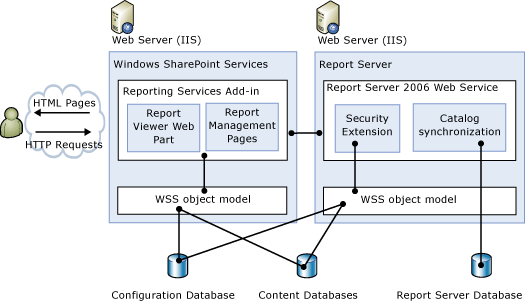







| SQL Server Setup Help | |
| Reporting Services and SharePoint Technology Integration | |
 See Also
See Also
|


|
| Configuring a SQL Server Installation > Reporting Services Configuration > Configuring Reporting Services for SharePoint 3.0 Integration > |
New: 12 December 2006
You can configure a report server to run within a deployment of a SharePoint product or technology and use the collaboration and centralized document management features of Windows SharePoint Services 3.0 or Office SharePoint Server 2007 with Reporting Services. Running a report server as part of a larger SharePoint deployment provides these levels of integration:
-
Shared storage.
-
Shared security.
-
Same site access for all business documents, including reports, report models, and shared data sources.
 Server Integration Architecture
Server Integration Architecture
When you integrate a report server with an instance of a SharePoint product or technology, items and properties are stored in the SharePoint content databases. This provides a deeper level of integration between the server technologies that effects how content is stored, secured, and accessed.
Storing report items and properties in SharePoint content databases allows you to browse SharePoint libraries for report server content types, secure items using the same permission levels and authentication provider that controls access to other business documents hosted on a SharePoint site, use the collaboration and document management features to check reports in and out for modification, use alerts to find out if an item has changed, and embed or customize the Report Viewer Web part on pages and sites within the application. Depending on your permissions, you can view and sometimes create reports and report models on a SharePoint site.
The report server continues to provide all data processing, rendering, and delivery. It also supports all scheduled report processing for snapshots and report history. The following diagram shows how the server components work together:

When you open a report from a SharePoint site, the report server proxy server endpoint connects to a report server, creates a session, prepares the report for processing, retrieves data, merges the report into the report layout, and displays it in the Report Viewer Web part. While the report is open, you can export it to different application formats, or interact with data by drilling into underlying numbers or clicking through to a related report. Export and report interaction operations are performed on the report server.
The report server synchronizes operations and data with Windows SharePoint Services and tracks information about the files it processes. When you modify properties or settings for any report server item, the change is stored in a SharePoint database and then copied to a report server database that provides internal storage to a report server.
 Components That Provide Integration
Components That Provide Integration
To combine the servers in a single deployment, you integrate an installation of Microsoft SQL Server 2005 Reporting Services with an instance of Windows SharePoint Services or Office SharePoint Server 2007.
Integration is provided through SQL Server 2005 Service Pack 2 and the SQL Server 2005 that reports Services Add-in for SharePoint Technologies. The Reporting Services Add-in is a freely distributable component that you can download from a Microsoft Web site and then install on a server that is running Windows SharePoint Services 3.0 or Office SharePoint Server 2007.
-
On Windows SharePoint Services, the Reporting Services Add-in provides a proxy server endpoint, a Report Viewer Web part, and application pages so that you can view, store, and manage report server content on a SharePoint site or farm.
-
On the report server, Service Pack 2 provides updated program files, a new SOAP endpoint, custom security and delivery extensions, a revised Reporting Services Configuration tool, scripts for granting access to SharePoint configuration and content databases, and a script for creating a report server database that supports SharePoint integrated mode. The report server must be configured to run in SharePoint integrated mode, dedicated exclusively to supporting report access and delivery through your SharePoint site.
After you install the Reporting Services Add-in on Windows SharePoint Services and configure the two servers for integration, you can upload or publish report server content types to a SharePoint library, and then view and manage those documents from a SharePoint site. Uploading or publishing report server content is an important first step; the Web Part and pages become available when you select report definitions (.rdl), report models (.smdl) and shared data sources (.rsds) on a SharePoint site.
 In This Section
In This Section
The following topics in this section provide additional information about how the servers work together. For installation recommendations and configuration steps, see Configuring Reporting Services for SharePoint 3.0 Integration.
- Features Supported by Reporting Services in SharePoint Integration Mode
-
Summarizes feature availability for a report server that is integrated with SharePoint technologies.
- Storing and Synchronizing Report Server Content With SharePoint Databases
-
Describes how report server integration is supported at the data layer. This overview provides an introduction to the data stores that are used and how content and properties are stored.
- Security Overview for Reporting Services in SharePoint Integration Mode
-
Describes how report server integration is also implemented at the security layer. Access to report server content and operations is supported by the authentication and authorization functionality in SharePoint technologies.
- Viewing and Managing Report Server Items from a SharePoint Site
-
Explains how report server integration extends to the Web application pages on SharePoint sites and in SharePoint Central Administration. With few exceptions, current users of Reporting Services will find that the functionality available on SharePoint sites is equivalent to Report Manager application pages.
 See Also
See Also
Concepts
Deployment Modes for Reporting ServicesInstalling the Reporting Services Add-in
Requirements for Running Reporting Services in SharePoint Integrated Mode
Comparing Levels of Integration Across Versions of Reporting Services and SharePoint Technologies
Other Resources
Using the Report Viewer Web Part on a SharePoint SiteDeploying Reports, Models, and Data Sources on a SharePoint Site